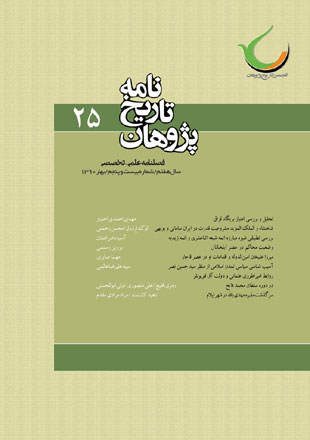An Introduction to the economic organization of eaRly Qajar Iran
Author(s):
Abstract:
Translated into Persian by:Mansoor Chehrazi and Mahboobeh Ahmadian This article is the substance of a paper read at the British Instilute of Persian studies, Tehran, on Saturday, June 29th 1963. In view of the jeneral neglect by historians of the economic history of Iran it is the aim of this article to examine some of the significant factors in the economic structure of Iran during the period betveen the death of Karim Khan Zand in 1779 and the Treaty of go Gulistan in 1813. These thirty-five years cover the period when Aghga Muhummad Khan overthrew all other contenders for mastery of the Iranian plateau and firmly established the Qaqjar dynasty on the peacock throne, as well as the first half of the long regin of his nephew, Fath’ Ali Shah.The principal sources for the economic survey which follows are the reports and personal impressions of some of the English travelers in Iran during this period. Although the accuracy of the facts recorded by these travelers naturally varies from individual tu individual, their value as sourcematerial (in view of the poverty of other sources of information) is very considerable. All of them spoke Persian in varying degrees of proficiency and a few were fluent readers of the language. Most of them spent severalmonths or, in some cases, several years in Iran. The majority were diplomats, soldiers or merchants of the East India Company who had-in Mysore, Hyderabad, or the outlying provinces of the Mughul or Ottoman empires-experienced societies not wholly dissimilar from that of late eighteens-century Iran. All were concerned with obtaining information for their employers and countrymen about a country, Iran, which was then comparatively little known to Europeans. With regard to the accuracy of their accounts of the economic life of Iran, it must be remembered that if, during this period, it was the supposed Oriental ambitions of Napeleon which were the immediate cause of british pre-occupation with Iran, the East India Company was still, at this time, a commercial corporation and therefore interested in Iran not only for strategic reasons but also as a potential market. It may therefor be safely assumed that the Company’s servants in Iran were expected to observe and record as accurately as possible the economic conditions of a country likely to be an area for future commercial expansion.
Language:
Persian
Published:
فصلنامه نامه تاریخ پژوهان, Volume:6 Issue: 23, 2011
Page:
173
magiran.com/p936954
دانلود و مطالعه متن این مقاله با یکی از روشهای زیر امکان پذیر است:
اشتراک شخصی
با عضویت و پرداخت آنلاین حق اشتراک یکساله به مبلغ 1,390,000ريال میتوانید 70 عنوان مطلب دانلود کنید!
اشتراک سازمانی
به کتابخانه دانشگاه یا محل کار خود پیشنهاد کنید تا اشتراک سازمانی این پایگاه را برای دسترسی نامحدود همه کاربران به متن مطالب تهیه نمایند!
توجه!
- حق عضویت دریافتی صرف حمایت از نشریات عضو و نگهداری، تکمیل و توسعه مگیران میشود.
- پرداخت حق اشتراک و دانلود مقالات اجازه بازنشر آن در سایر رسانههای چاپی و دیجیتال را به کاربر نمیدهد.
In order to view content subscription is required
Personal subscription
Subscribe magiran.com for 70 € euros via PayPal and download 70 articles during a year.
Organization subscription
Please contact us to subscribe your university or library for unlimited access!


